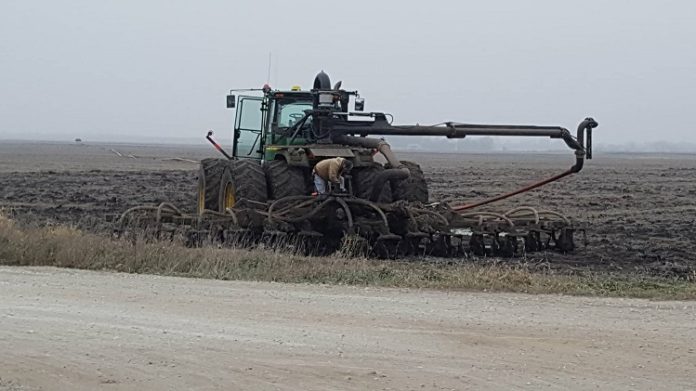Instead of sitting high and dry for harvest and fall manure application, virtually every county in the state now has saturated soils, ponded fields and high running streams. Manure applicators are waiting for that one dry week, and producers are worrying about emptying their CAFO manure pits and compacting soils.
“Don’t panic,” said Ken Hessenius, supervisor of the Iowa Department of Natural Resources (DNR) Spencer field office. “While there are no good options when storage is full and the ground is wet, there are still some things confinement site owners and commercial manure applicators can do.”
When soils are saturated, “the main thing is to keep manure from reaching a creek via surface runoff or through a tile line or the ground water,” Hessenius said. Save those valuable nutrients by reducing runoff. Here are some DNR tips:
- Call the DNR field office and discuss site-specific options and how to minimize problems.
- Partially empty basins. If the pit, basin or lagoon is full, consider partially emptying it by enough to get you through until the fields dry up or — worst-case scenario — until next spring. Maintain freeboard, if possible: 2 feet for earthen basins and 1 foot for formed structures.
- Pick the best field: If fields stay saturated, you might have to adjust what you can apply on each field or determine which fields are best suited for application. Look first for areas far from environmentally sensitive spots, such as like wetlands, streams or wells. High, level spots in the field may dry out sooner and have less potential for runoff.
- Partial fills. Consider filling the tankers just partway to avoid compaction.
- Reduce application rates. Consider cutting back to rates that will not cause run-off, for example, limit gallons applied per acre, especially if pumping from a lagoon.
- Surface apply. If you can’t inject or incorporate your manure into the soil, then consider revising the manure management plan (MMP) for surface application.
- Meet separation distances. If surface applying, you must be able to meet separation distances — generally 200 feet from sinkholes, drinking water wells, designated wetlands, water sources and inlets to ag drainage wells; 800 feet from high-quality water resources; and 750 feet from buildings, such as residences, and public-use areas. See the DNR fact sheets: Separation Distances for Land Application of Manure and High Quality Water Resources for more information.
- Discuss your options. Confinement owners/managers and commercial applicators should discuss available possibilities. The facility must receive written approval from a field office prior to surface application of manure if the facility previously obtained points on the Master Matrix for injection or incorporation of manure. Check with neighbors for crop fields or storage options. Consider moving manure to temporary storage in older buildings with pits, or to basins or slurry stores.
- Spread it out. If surface applying, it’s probably better to use a splash pad or other spreading equipment, instead of concentrating manure flow by dribbling it on through the injectors.
- Pay attention to the land. If at all possible,avoid slopes over 5 percent. Do not surface apply in fields prone to flooding. Spring flooding can wash manure downstream, losing crop
nutrients and degrading water quality.
- Plan for winter. While it’s not ideal, there is an extreme weather exception for applying on snow-covered (after Dec. 20) or frozen ground (after Jan. 31). To use it:
Notify the DNR field office first.
To minimize chances of a water quality impact or fish kill, follow Iowa State University Extension’s recommendations in “Winter Manure Application,” which is summarized here:
- Apply as early in the season as possible.
- Pick fields with the least snow cover.
- In late winter, wait until snow has melted before applying.
- If you can’t inject or incorporate, revise the MMP for surface application and follow tips 4 through 7 above.
- Apply on soybean stubble (instead of corn stubble) when possible because it has less snow cover.
- Avoid application near tile inlets that drain to surface or ground water.
- Avoid application in grassed waterways, and avoid damaging grassed waterways.
- Consider covering tile inlets to prevent manure from entering tiles lines directly.
- Watch the weather. Check the forecast and avoid applying before precipitation to let manure soak into the soil.
Note: State law and rules say confinements, that is, totally roofed facilities, must retain all manure between periods of manure application. Both the facility owner and the manure applicator are responsible for keeping manure out of waters of the state.
















